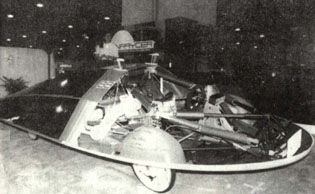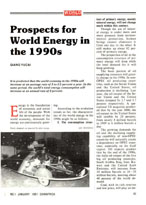It is predicted that the world economy in the 1990s will increase at an average rate of 3 to 3.5 percent a year. In the same period, the world’s total energy comsumption will increase at an annual rate of 2 percent.
Energy is the foundation of economic and social life of the people. With the development of the world economy, demands for energy are continuously growing.
According to the evolution trends so far, the characteristics of the world energy in the 1990s might be as follows:
Ⅰ. The consumption structure of primary energy, mainly mineral energy, will not change much within this century.
Though the use of mineral energy is under more and more pressure from environmental protection, human beings cannot eliminate it from one day to the other. It still makes up about 82 percent of primary energy.
The proportion of oil in the consumption structure of primary energy will drop while the total demand for it will keep growing.
The basic pattern of oil supplying resources will greatly change in the 1990s. In non-OPEC oil producing countries, such as the Soviet Union and the United States, oil production is declining. Last year, the oil output of the Soviet Union and the United Stales dropped by 2.7 and 5.7 percent respectively. A specialized US magazine predicted that by the year 2000, the oil output in the United States will tumble by 25 percent, from nearly 8 million barrels in 1989 to 6 million barrels a day.
The growing demands for oil and the declining supplying capability of non-OPEC countries will naturally create a dependence on OPEC countries, especially on the Gulf region. Oil experts predict that by the end of the 1990s, the daily oil output of the five big oil producing countries, Saudi Arabia, Iraq, Iran, Kuwait and the United Arab Emirates, will increase from 18 million barrels to 24—25 million barrels, meeting about 40 percent of the world demand.
Coal, with its rich reserves and low price, will play an important role in the 1990s, especially for the electric energy system. It is said that 50 percent of the increase of world electricity will be supplied bycoal-burning power plants. The world’s demand for coal increased 30 percent in the past ten years, reaching 4.5 billion tons in 1988. However, technologies and efficiency should be improved to fully utilize coal.
In regard to environmental protection, natural gas is undoubtedly the best energy resource. By January 1, 1989, the known natural gas reserve in the world was 116,000 billion cubic metres, which equals 104.7 billion tons of oil. In the next ten years, the annual increase of the world natural gas consumption will be 2.5 percent. By 1995, gas consumption will be equivalent to 22 to 23 million barrels of oil per day, and by the year 2000, it will be equivalent to 25 to 26 million barrels of oil per day.
Ⅱ. Nuclear Power to Be Further Developed.
During the two oil crisis, nuclear power emerged as the best substitute to oil. However, after the Chernobyl nuclear disaster in the Soviet Union in April 1986, the development of nuclear power suffered serious setbacks. The nuclear safety coefficient became a key problem. At present, the tendency is to develop advanced nuclear reactors with passive or intrinsic safety characteristics. Some countries are constructing nuclear power installations at low cost that are smaller, simpler and safer.
Besides safety, another important problem is the efficient utilization of uranium. If the new proliferation reactor now in research can succeed and gain economic competitiveness on the energy market, it will open a new world for nuclear development.
According to the predictions of the international nuclear power organization, the world’s nuclear power capacity will increase from 297,900 megawatts in 1987 to 444,000—485,000 megawatts by the year 2000. The proportion of nuclear power in the world’s total electric power will increase from 16.2 percent in 1987 to 17—18 percent in 1995.
Ⅲ. Rich Regenerated Energy Enters the Energy Market.
Regenerated energy is obtained by transforming sun and terrestrial heat, wind and water forces and organic living beings into energy, fuel, heat and electricity.
The technology to develop regenerated energy, especially solar energy, will be stressed in the next ten years. Today, many villages and towns throughout the world have electricity from solar energy, using it for lighting, water pumping, communication system and medical refrigeration.
The resources of regenerated energy are very rich. The solar energy the earth receives is 3,000 times the energy consumption of the whole world. The wind energy that can be used is about 10 billion kilowatts. In the last 15 years, 100,000 windmills have been installed worldwide and 2.5 million kilowatts of wind energy was utilized; of these, 1.5 million kilowatts was used to generate electricity and the rest to activate mechanical devices, such as water pumps, grinders, etc. In the next five years, the increasing potential of wind-power electricity is expected to reach 300,000 to 400,000 kilowatts annually. The terrestrial heat stored up in the earth is 170 million times the reserve of coal. As of early 1989, 20 countries had developed 66 terrestrial heat fields and installed 233 generators, producing 5.136 million kilowatts. It was predicted that by the year 2000, the terrestrial heat generating capacity would reach 100 million kilowatts. Tidal energy, which is very economical, reaches about 200 billion kilowatt-hour. Yet, only 600 million kilowatt-hour is used to generate electricity. By the year 2000, the annual electricity generated by tidal energy stations will reach 30 to 40 billion kilowatt-hour.
However, because of limited technology and funds, regenerated energy lacks competitiveness. Hence it cannot make up a large proportion of the energy consumption structure in the next decade.
Ⅳ. Nuclear Fusion Might Be Man’s Best Choice
The basic fuel for nuclear fusion comes from the sea. According to estimates, the quantity of deuterium, or heavy hydrogen, contained in oceans is about 25,000 billion tons. When used in nuclear fusion, deuterium produces enough energy to meet world demand for billions of years. At present, more than 40 countries are conducting researches and technical experiments in this field. Scientists predict that a breakthrough in nuclear fusion will be made in the 1990s, and that nuclear fusion will be used commercially around the year 2030.
Ⅴ. Energy Consumption Will Change Tremendously
High energy-consuming industries will find more economical and wiser way of using energy, with less waste. High-tech industries will gradually become the mainstay.
Experts estimate that the energy demand can be reduced by 25-30 percent through energy conservation. They think that the United States can save 50 percent of its energy without reducing its standard of living. Japanese scholars think that by the year 2000, Japan can save 24.5 percent of its energy.
With the adjustment of the world’s industrial structure, the updating of technical equipment, the transformation of technological process, the reduction of energy consumption and the improvement of energy utilization will enable the energy consumption pattern to be more rational.
VI. Energy Consumption to Emphasize Environmental Protection
Today, the negative effects of acid rain, the greenhouse effect, on the ecological balance and man’s environment are directly related to the energy consumption. It is estimated that 5.5 billion tons of carbon is released into the air every year. Carbon dioxide produced by burning minerals in the United States makes up 25 percent of the world’s emission—more than 1 billion tons annually. Fuel is the main source of pollution. A coal-burning power station with a capacity of 1 million kilowatts burns about 3 million tons of coal, produces 700,000 tons of carbon dioxide, 120,000 tons of sulphur dioxide, 20,000 tons of nitrogen oxide and 750,000 tons of ashes. Carbon dioxide and nitrogen oxide produce acid rains which are harmful to crops, forests and aquatic organisms while eating up buildings.
To protect the environment, it is necessary to readjust energy consumption, reduce the use of mineral energy and develop a cleaner source of energy. However, this cannot be realized in a short time. The most important thing at present is to improve the way of utilizing mineral energy and reduce the discharge of carbon dioxide and sulphur dioxide.

Newly designed car powered by solar energy. LIU XINNING


 Copy Reference
Copy Reference 